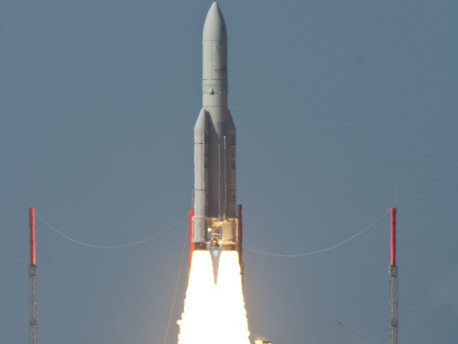A flawless launch
Hylas-1 in orbit brings Europe broadband from space
 © ESA/CNES/ARIANESPACE - Optique Video CSG - S. Martin, 2010
|
On 26 November 2010, an Ariane 5 launcher lifted off from Europe’s Spaceport in French Guiana on its mission to place two telecommunications satellites, Hylas-1 and Intelsat 17, into their planned transfer orbits. Liftoff of V198, the 54th Ariane 5 flight, came at 19:39 CET (18:39 GMT; 15:39 French Guiana).
The 54th Ariane 5 (V198) lifted off from Kourou, French Guiana, at 15:39 local time (18:39 GMT, 19:39 CET) and released its two payloads, Hylas-1 and Intelsat-17, into their planned transfer orbits.
ESA has devoted years to developing satellite broadband technologies through its Advanced Research in Telecommunication Systems (ARTES) programme. Now several of these innovations are being put to work on Hylas-1.
ESA’s involvement focuses on the mission’s most inventive element – its highly adaptable payload. The satellite’s flexible technology means that it can modify its data throughput across the European regions it serves, keeping pace with market demand.
“ESA’s cooperation with Avanti Communications on Hylas-1 is a prime example of a public–private partnership, a creative fast-track for demonstrating and reaping the benefits of satellite high technology as part of an operational mission,” commented Magali Vaissiere, ESA Director of Telecommunications and Integrated Applications.
This is a new way of working that ESA will pursue in telecoms. Within the next 24 months, two similar initiatives in partnership with satellite operators Inmarsat and Hispasat will foster the development of state-of-the-art technologies to serve the new needs of the worldwide market and Europe’s citizens.
Source: ESA
A flawless launch
Hylas-1 in orbit brings Europe broadband from space
 © ESA/CNES/ARIANESPACE - Optique Video CSG - S. Martin, 2010
|
On 26 November 2010, an Ariane 5 launcher lifted off from Europe’s Spaceport in French Guiana on its mission to place two telecommunications satellites, Hylas-1 and Intelsat 17, into their planned transfer orbits. Liftoff of V198, the 54th Ariane 5 flight, came at 19:39 CET (18:39 GMT; 15:39 French Guiana).
The 54th Ariane 5 (V198) lifted off from Kourou, French Guiana, at 15:39 local time (18:39 GMT, 19:39 CET) and released its two payloads, Hylas-1 and Intelsat-17, into their planned transfer orbits.
ESA has devoted years to developing satellite broadband technologies through its Advanced Research in Telecommunication Systems (ARTES) programme. Now several of these innovations are being put to work on Hylas-1.
ESA’s involvement focuses on the mission’s most inventive element – its highly adaptable payload. The satellite’s flexible technology means that it can modify its data throughput across the European regions it serves, keeping pace with market demand.
“ESA’s cooperation with Avanti Communications on Hylas-1 is a prime example of a public–private partnership, a creative fast-track for demonstrating and reaping the benefits of satellite high technology as part of an operational mission,” commented Magali Vaissiere, ESA Director of Telecommunications and Integrated Applications.
This is a new way of working that ESA will pursue in telecoms. Within the next 24 months, two similar initiatives in partnership with satellite operators Inmarsat and Hispasat will foster the development of state-of-the-art technologies to serve the new needs of the worldwide market and Europe’s citizens.
Source: ESA





